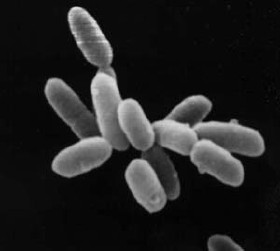Euryarchaeota facts for kids
Quick facts for kids Euryarchaeota |
|
|---|---|
 |
|
| Halobacterium sp. strain NRC-1, each cell about 5 µm in length. | |
| Scientific classification | |
| Domain: | |
| Kingdom: |
Euryarchaeota
Woese, Kandler & Wheelis, 1990
|
| Phyla | |
|
|
| Synonyms | |
|
|
Euryarchaeota are a special group of tiny living things called Archaea. They are so small you can only see them with a powerful microscope! Think of them as one of the two main families of archaea. The name "Euryarchaeota" means "broad old quality" in Greek.
These tiny organisms are super diverse. Some are methanogens, which means they make methane gas. You can often find these in animal intestines. Others are halobacteria, which love to live in places with lots of salt. They can even survive in extremely salty water! There are also some Euryarchaeota that love extreme heat. These "thermophiles" can live in temperatures from 41 to 122 degrees Celsius. Scientists group Euryarchaeota together mainly because of their unique rRNA sequences and special DNA.
Contents
What Are Euryarchaeota Like?
Euryarchaeota come in many different shapes and have various ways of living. Some look like tiny rods, while others are shaped like balls.
Scientists use a test called a Gram stain to tell bacteria apart. Euryarchaeota can appear either gram-positive or gram-negative. This depends on whether their cell wall has a special material called pseudomurein.
These amazing organisms have many different lifestyles. Some make methane, some love salt, and others reduce sulfates. Many are also extreme heat-lovers. You can even find some Euryarchaeota floating in the ocean with plankton and bacteria. It's hard to grow and study these ocean Euryarchaeota in a lab. But, by looking at their DNA, scientists think they can move around and get their food from other sources (they are heterotrophs).
Where Do Euryarchaeota Live?
For a long time, people thought Euryarchaeota only lived in extreme places. These places had very high or low temperatures, lots of salt, or unusual pH levels. But in 2019, scientists found them in more normal environments too.
For example, they were found in cold, acidic places. In some of these spots, there were more Euryarchaeota than bacteria! They have also been found in water springs, marshlands, soil, and around plant roots (called rhizospheres).
Some Euryarchaeota are very good at adapting. A group called Halobacteriales usually lives in super salty and sulfur-rich places. But they can also grow in water that's only as salty as seawater. That's about 2.5% salt!
In plant roots, Euryarchaeota seem to depend on mycorrhizal fungi. If there were more fungi, there were more Euryarchaeota. If there were no fungi, there were no Euryarchaeota.
How Scientists Group Euryarchaeota
Scientists use special methods to understand how different living things are related. This is called phylogeny. For Euryarchaeota, they often look at their 16S rRNA. This is a part of their genetic material.
This helps them create a "family tree" for these tiny organisms. It shows how different groups of Euryarchaeota are connected to each other. It's like figuring out who is related to whom in a big family!
See also
 In Spanish: Euryarchaeota para niños
In Spanish: Euryarchaeota para niños

